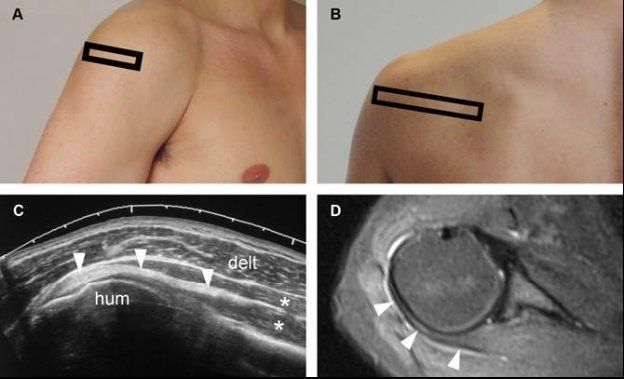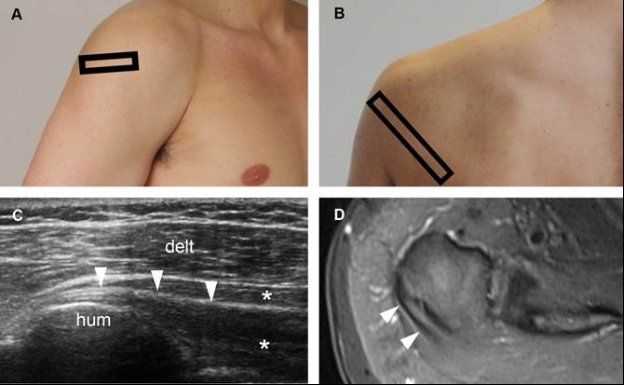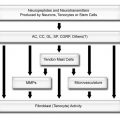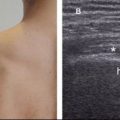Figure 1-10. Subscapularis tendon. [A] Positioning of the probe. [B] Corresponding long-axis 12-5 MHz US image shows the subscapularis tendon as a hyperechoic fibrillar structure (arrowheads) located deep to the deltoid muscle (delt). [C] Corresponding axial STIR MRI shows normal subscapularis tendon (arrowheads). Hum= humerus.

Figure 1-11. Supraspinatus tendon. [A] Patient positioning. [B] Positioning of the probe. [C] Corresponding long-axis 12-5 MHz US image shows the supraspinatus tendon as a hyperechoic fibrillar structure (arrowheads) located deep to the deltoid muscle (delt). [D] Corresponding coronal oblique STIR MRI shows normal supraspinatus tendon (arrowheads). Hum= humerus.

Figure 1-12. Infraspinatus tendon. [A] Anterolateral positioning of the probe. Patient positioning is the same as shown in figure 1-11A. [B] Posterior positioning of the probe. [C] Corresponding extended field of view 12-5 MHz US image shows the hyperechoic fibrillar tendon (arrowheads) originating from the predominantly hypoechoic infraspinatus muscle (asterisks). [D] Corresponding axial STIR MRI shows normal infraspinatus tendon (arrowheads). Hum= humerus. Delt= deltoid.

Figure 1-13. Teres minor tendon. [A] Anterolateral positioning of the probe. Patient positioning is the same as shown in figure 1-11A. [B] Posterior positioning of the probe. [C] Corresponding long-axis 12-5 MHz US image shows the hyperechoic fibrillar tendon (arrowheads) originating from the predominantly hypoechoic teres minor muscle (asterisks). [D] Corresponding axial STIR MRI shows normal teres minor tendon (arrowheads). Hum= humerus. Delt= deltoid.
A key component to diagnosis is dynamic evaluation, especially if impingement is suspected. The manoeuver to demonstrate subcoracoid impingement consists of moving the shoulder from external rotation to a flexed, adducted, and internally rotated position (video 1-1). Subacromial impingement is difficult to demonstrate because only the superior surface of the acromion is imaged, with acoustic shadowing beyond. However, it can occasionally be depicted by placing the probe over the lateral acromion in coronal oblique position and asking the patient to abduct the shoulder (video 1-2). To the best of our knowledge, dynamic US evaluation of internal impingement has never been described.
Stay updated, free articles. Join our Telegram channel

Full access? Get Clinical Tree





